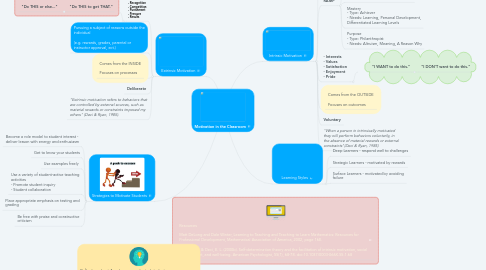Motivation in the Classroom
by Janice Gutierrez


1. Extrinsic Motivation
1.1. - Benefits - Rewards - Recognition - Competition - Punishment - Pressure - Results
1.1.1. "Do THIS to get THAT."
1.1.1.1. "Do THIS or else..."
1.2. Pursuing a subject of reasons outside the individual (e.g. rewards, grades, parental or instructor approval, ect.)
1.3. Comes from the INSIDE Focuses on processes
1.4. Deliberate
1.5. "Extrinsic motivation refers to behaviors that are controlled by external sources, such as material rewards or constraints imposed my others" (Deci & Ryan, 1985).
2. Strategies to Motivate Students
2.1. Become a role model to student interest - deliver lesson with energy and enthusiasm
2.2. Get to know your students
2.3. Use examples freely
2.4. Use a variety of student-active teaching activities - Promote student inquiry - Student collaboration
2.5. Place appropriate emphasis on testing and grading
2.6. Be free with praise and constructive criticism
3. Resources Matt DeLong and Dale Winter, Learning to Teaching and Teaching to Learn Mathematics: Resources for Professional Development, Mathematical Association of America, 2002, page 168. Ryan, R. M., & Deci, E. L. (2000b). Self-determination theory and the facilitation of intrinsic motivation, social development, and well-being. American Psychologist, 55(1), 68-78. doi:10.1037/0003-066X.55.1.68
4. Reflection about Angel; my unmotivated student: After reading this week's readings and presentations, I have reflected that Angel's learning style is a Surface Learner who is motivated by avoiding failure. I have noticed that he chooses to do only the minimum effort in classroom tasks. My role as an educator is to tailor my lessons and prompting by helping him gain confidence to learn and perform. I can do that my scaffolding his learning through designing lessons that build up little by little of complexity. I need to continue to encourage him and other Surface Learners and help them reflect on what they have learned and accomplished.
5. Intrinsic Motivation
5.1. Inherent interest in pursuing a topic
5.2. RAMP
5.2.1. Relatedness - Type: Socialiser - Needs: Social Status, Social Connections, Belonging
5.2.2. Autonomy - Type: Free Spirit - Needs: Creativity, Choice, Freedom, Responsibility
5.2.3. Mastery - Type: Achiever - Needs: Learning, Personal Development, Differentiated Learning Levels
5.2.4. Purpose - Type: Philanthropist - Needs: Altruism, Meaning, A Reason Why
5.3. - Interests - Values - Satisfaction - Enjoyment - Pride
5.3.1. "I WANT to do this."
5.3.1.1. "I DON'T want to do this."

